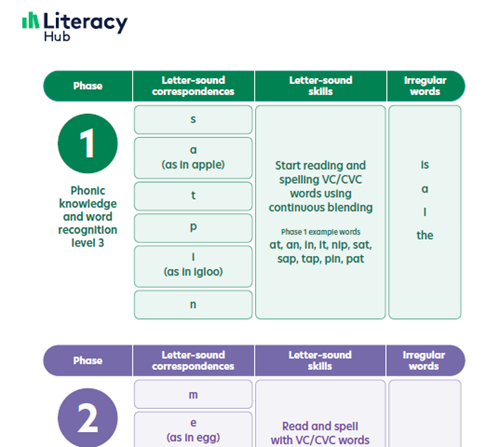Literacy Hub phonics progression
Categories
Audience
Purpose
Topic
Details
Source
Literacy Hub
Copyright
(c) Commonwealth of Australia
Overview
The Literacy Hub phonics progression includes a sequence of letter–sound correspondences and phonics skills for development across Foundation to Year 2.
Who is this document for?
Foundation to Year 2 teachers; school leaders.
What will you learn?
Why and how to use a phonics progression.
A suggested order for teaching letter–sound correspondences.
Update September 2025
Some minor amendments were made to the progression in September 2025 to clarify some concepts. It’s important to note that the amendments in this version are not extensive, and you can continue to use the previous version with no issues. If you’re using the Literacy Hub’s phonics and morphology lesson packs, you’ll notice a closer alignment with the new version of the progression.
- Each phase is now matched to a year level and a level in the general capabilities in the Australian Curriculum, to show the expected achievement for students for this phase.
- The example word lists have been improved to provide clearer examples for teachers.
- Phase 5: q has been changed to qu, to make it clearer for teachers that teaching qu as a spelling pattern is most helpful for student learning.
- Phase 9: a more precise meaning for the -s/-ed (present simple verb) suffix is included.
- Phase 12: a morphology column has been added to more clearly show where to teach the -y suffix. Compound words have been included to prompt teachers to teach this concept explicitly.
- Phase 13: the title of the morphology focus has been changed to final e + vowel suffixes to include split digraph words ending in e and to highlight to teachers that this suffix convention applies to vowel suffixes generally.
- Phase 14: the title of the morphology focus has been changed to 1-1-1 base words + vowel suffixes (double the final consonant) to include which base words this suffix convention applies to and to highlight to teachers that this applies to vowel suffixes generally.
- Phase 15: final silent e has been added to this phase to cover this concept more thoroughly within the progression. Introducing final silent e here will complement teaching of soft g/c in Phase 17 and of _le in Phase 19, which will also refer to silent final e.
Related content
Phonics and morphology lesson packs
Download free lesson packs, aligned with the Literacy Hub phonics progression. These ready-to-use packs include lesson slides with teacher notes, student sheets, progress monitoring tools and decodable resources.
Phonics instructional model for reading and spelling
This instructional model shows how to structure a phonics lesson using explicit direct instruction.
Morphology instructional model
This instructional model for morphology outlines the attributes of instruction, a lesson and review model and a sample morphology lesson plan.
Introduction to SSP video series
Jocelyn Seamer, an expert in systematic reading instruction, presents a series of videos about systematic synthetic phonics (SSP). View the first video in the series.
Phonics professional learning: getting started with a phonics progression
The Literacy Hub provides free, online professional learning to support schools through each step of building a systematic synthetic phonics (SSP) approach for reading and spelling. This first topic in the series addresses phonics progressions and phonological awareness.
